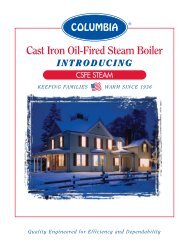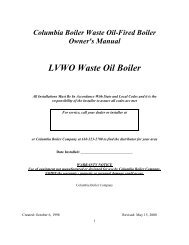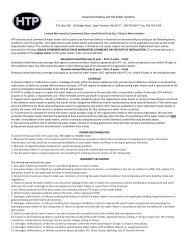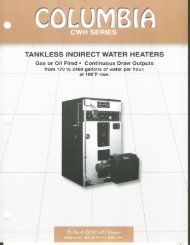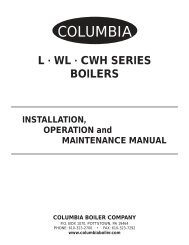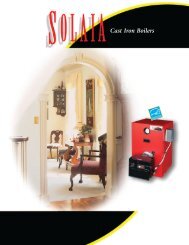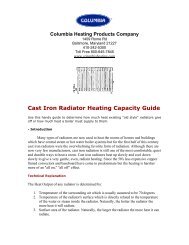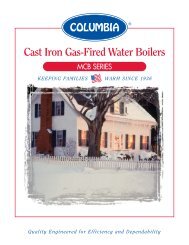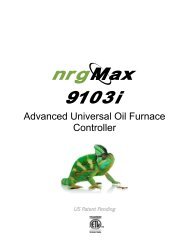Download Installation Manual (.pdf) - Heat Transfer Products, Inc
Download Installation Manual (.pdf) - Heat Transfer Products, Inc
Download Installation Manual (.pdf) - Heat Transfer Products, Inc
You also want an ePaper? Increase the reach of your titles
YUMPU automatically turns print PDFs into web optimized ePapers that Google loves.
6measurement used in the U.S. water heater industry. Hardness expressed as mg/L or ppm may be divided by 17.1 to convert to grainsper gallon. Water may be classified as very soft, slightly hard, moderately hard, or hard based on its hardness number. The minerals inthe water precipitate out as the water is heated and cause accelerated lime scale accumulation on a heat transfer surface. This limescale build-up may result in premature failure of the heat exchanger. Operating temperatures above 135 o F will further accelerate thebuild-up of lime scale on the heating surface and may shorten the service life of the water heater.Water that is classified as hard and very hard must be softened to avoid heat exchanger failure. See further information about waterhardness on page 7.CLASSIFICATION MG/L OR PPM GRAINS/GALSoft 0 – 17.1 0 - 1Slightly Hard 17.1 – 60 1 – 3.5Moderately Hard 60 – 120 3.5 – 7.0Hard 120 – 180 7.0 – 10.5Very Hard 180 and over 10.5 and overIf the hardness of the water exceeds the maximum level of 7 grains per gallon, water should be softened to a hardness level no lowerthan 5 grains per gallon. Water softened as low as 0 to 1 grain per gallon may be under-saturated with respect to calcium carbonate,resulting in water that is aggressive and corrosive.pH of WaterpH is a measure of relative acidity, neutrality or alkalinity. Dissolved minerals and gases affect water pH. The pH scale ranges from 0 to14. Water with a pH of 7.0 is considered neutral. Water with a pH lower than 7 is considered acidic. Water pH higher than 7 isconsidered alkaline. A neutral pH (around 7) is desirable for most potable water applications. Corrosion damage and heater failuresresulting from water pH levels of lower than 6 or higher than 8 ARE NOT covered by the warranty. The ideal pH range for waterused in a storage tank or a water heater system is 7.2 to 7.8.Total Dissolved SolidsTotal Dissolved Solids (TDS) is a measurement of all minerals and solids dissolved in a water sample. The concentration of totaldissolved solids is usually expressed in parts per million (ppm).Water with a high TDS concentration will greatly accelerate lime and scale formation in the hot water system. Most high TDSconcentrations precipitate out of the water when heated. This can generate a scale accumulation on the heat transfer surface that willgreatly reduce the service life of a water heater. This scale accumulation can also impede the ability of the heat exchanger to transferheat into the water. A heat exchanger damaged or blocked by lime/scale accumulation must be replaced.The manufacturer of the water heater has no control of water quality, especially TDS levels in your system. Total dissolved solids inexcess of 2,000 ppm will accelerate lime and scale formation in the heat exchanger. <strong>Heat</strong> exchanger failure due to total dissolved solidsin excess of 2,000 ppm is a non-warrantable condition. Failure of a water heater due to lime scale build up on the heating surfaceIS NOT covered by the warranty.Hardness: 7 grainsChloride levels: 100 ppmpH levels: 6-8TDS: 2000 ppmSodium: 20 mGLF. OPTIONAL EQUIPMENTBelow is a list of optional equipment available from HTP. These additional options may be purchased through your HTP distributor.High Altitude Kit Part # 8800P-024 – 125 kBTU Part # 8800P-025 – 150 kBTU Part # 8800P-026 – 199.9 kBTU Part # 8800P-027 – 250 kBTU Part # 8800P-028 – 300 kBTUPower Venter Part # 6060-200 – 125 kBTU Part # 6060-201 – 150 – 300 kBTU modelsVent Termination Kit Part # 6060-202 – 125 kBTU Part # 6060-203 – 150 – 300 kBTU models



